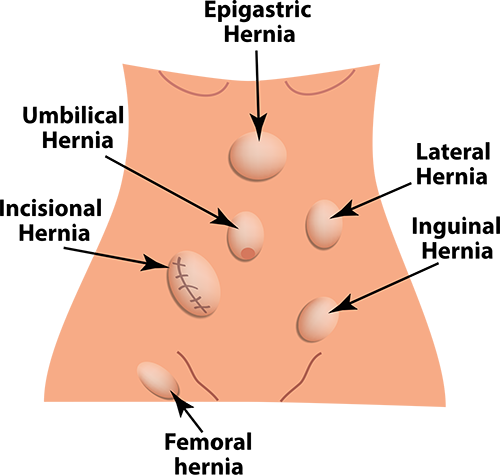Archive for April, 2021
 A hernia is best explained as “a hole in the wall.” It occurs when there is a defect or “hole” in the strength layer of your abdominal wall, which is called the fascia. There are several different types of hernias and each must be treated accordingly.
A hernia is best explained as “a hole in the wall.” It occurs when there is a defect or “hole” in the strength layer of your abdominal wall, which is called the fascia. There are several different types of hernias and each must be treated accordingly.
Where do hernias typically occur?
A hernia most commonly occurs within the torso, between the chest and hips, often occurring in the groin or belly button. Sometimes, the underlying fat or an internal organ can protrude out through the “hole” and this results in a bulge. That bulge can be painful at times, especially with physical activity.
What are the different types of hernias?
- Inguinal hernia: This is a hernia that affects the inguinal canal—a passageway for spermatic cord and blood vessels leading to the testicles in men, and the round ligament that gives support for the womb in women. When a patient is suffering from an inguinal hernia, intestine or fatty tissue pokes into the groin near the top of the inner thigh. This type of hernia impacts men more often than women.
- Femoral hernia: Similar to the inguinal hernia, the femoral hernia often protrudes through the groin at the top of the inner thigh. However, these are much less common than inguinal hernias and often affect older women.
- Umbilical hernia: An umbilical hernia occurs when fatty tissue or part of the intestine protrudes through the abdominal wall near the belly button.
- Incisional hernia: After undergoing an abdominal or pelvic operation, it is possible for the tissue in this area to split open, allowing underlying tissue to push through the site of the scar, causing a hernia.
- Epigastric hernia: When there is a defect in the fascia allowing fatty tissue to push through the abdominal wall between your belly button and your sternum, it’s called an epigastric hernia.
- Spigelian hernia: This type of hernia occurs when there is a defect in the fascia on the sides of the abdomen and below the belly button.
How are hernias treated?
Hernias are repaired through hernia surgery and are a commonly performed procedure by our board-certified general surgeons here at The Premier Surgical Network. There are two main types of hernia repair, open and laparoscopic.
Open hernia repair involves the surgeon creating an incision and identifying the hernia “sac,” which contains the bulging tissue. Then, the hernia is pushed back into the abdomen and the hernia defect of the abdominal wall is closed with stitches and/or synthetic mesh. Recovery is usually quick with this procedure; most patients return home a few hours after the surgery and may begin to feel better within a few days. However, the patient should not resume strenuous activity, exercise, or lifting for at least six weeks after the surgery.
Laparoscopic surgery is one of the most minimally invasive ways to correct a hernia. The surgeon uses a laparoscope, which is a thin, telescope-like instrument that is inserted through a small incision in the patient’s abdominal wall or belly button (umbilicus). While this surgery is much less invasive than other options, it does require that the patient is under anesthesia. The patient does not feel any pain during this surgery and is left with very small scars. However, the patient should not resume strenuous activity, exercise, or lifting for at least six weeks after the surgery.
To set up an appointment or learn more about hernia repair surgery, call our office today: 844-973-0002
